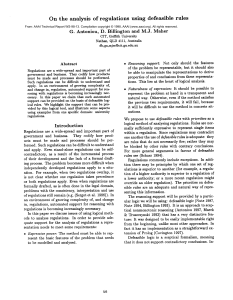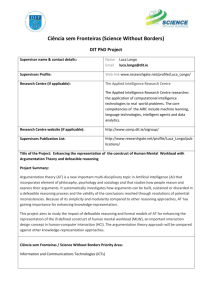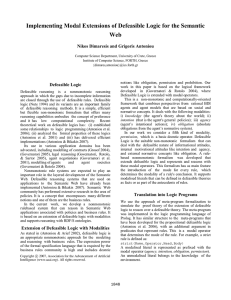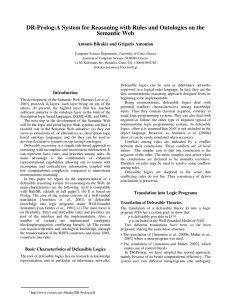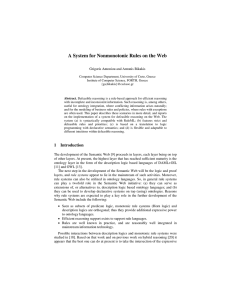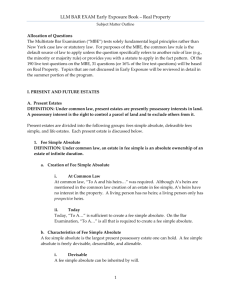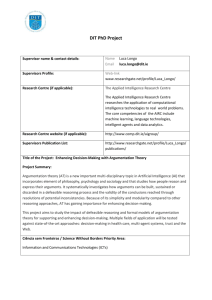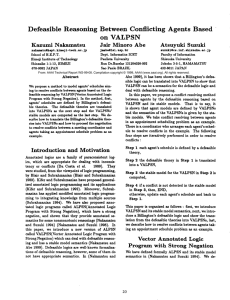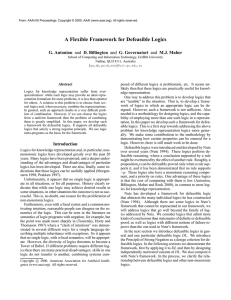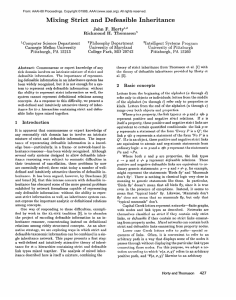A Defeasible Logic Programming System for the Web
advertisement
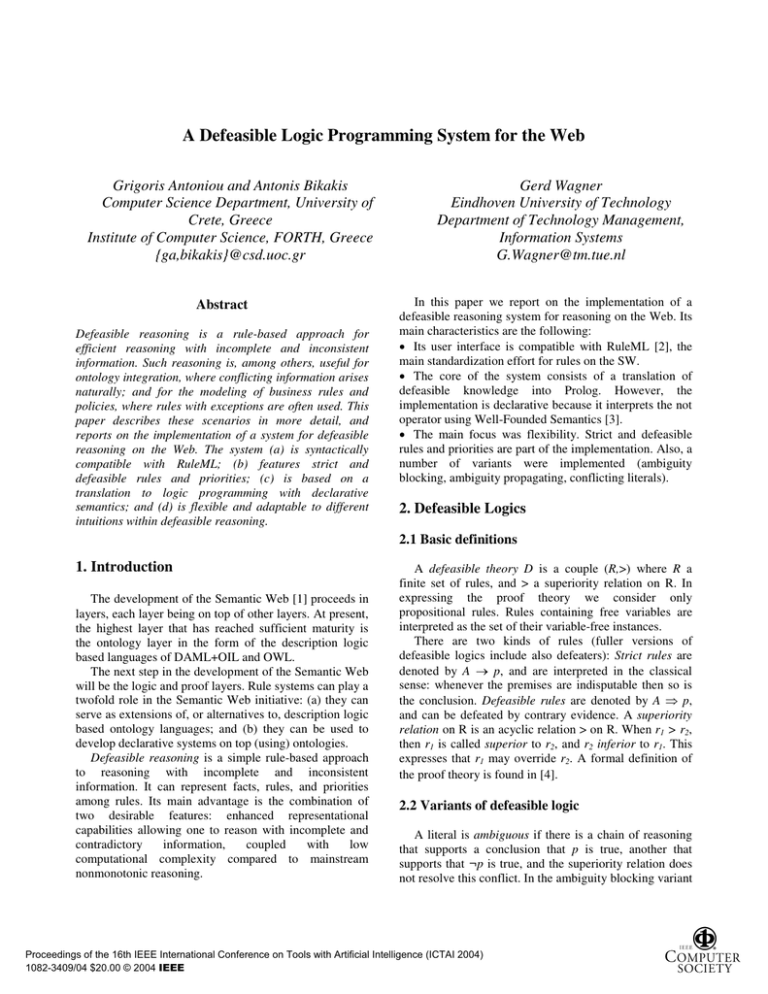
A Defeasible Logic Programming System for the Web
Grigoris Antoniou and Antonis Bikakis
Computer Science Department, University of
Crete, Greece
Institute of Computer Science, FORTH, Greece
{ga,bikakis}@csd.uoc.gr
Abstract
Defeasible reasoning is a rule-based approach for
efficient reasoning with incomplete and inconsistent
information. Such reasoning is, among others, useful for
ontology integration, where conflicting information arises
naturally; and for the modeling of business rules and
policies, where rules with exceptions are often used. This
paper describes these scenarios in more detail, and
reports on the implementation of a system for defeasible
reasoning on the Web. The system (a) is syntactically
compatible with RuleML; (b) features strict and
defeasible rules and priorities; (c) is based on a
translation to logic programming with declarative
semantics; and (d) is flexible and adaptable to different
intuitions within defeasible reasoning.
Gerd Wagner
Eindhoven University of Technology
Department of Technology Management,
Information Systems
G.Wagner@tm.tue.nl
In this paper we report on the implementation of a
defeasible reasoning system for reasoning on the Web. Its
main characteristics are the following:
x Its user interface is compatible with RuleML [2], the
main standardization effort for rules on the SW.
x The core of the system consists of a translation of
defeasible knowledge into Prolog. However, the
implementation is declarative because it interprets the not
operator using Well-Founded Semantics [3].
x The main focus was flexibility. Strict and defeasible
rules and priorities are part of the implementation. Also, a
number of variants were implemented (ambiguity
blocking, ambiguity propagating, conflicting literals).
2. Defeasible Logics
2.1 Basic definitions
1. Introduction
The development of the Semantic Web [1] proceeds in
layers, each layer being on top of other layers. At present,
the highest layer that has reached sufficient maturity is
the ontology layer in the form of the description logic
based languages of DAML+OIL and OWL.
The next step in the development of the Semantic Web
will be the logic and proof layers. Rule systems can play a
twofold role in the Semantic Web initiative: (a) they can
serve as extensions of, or alternatives to, description logic
based ontology languages; and (b) they can be used to
develop declarative systems on top (using) ontologies.
Defeasible reasoning is a simple rule-based approach
to reasoning with incomplete and inconsistent
information. It can represent facts, rules, and priorities
among rules. Its main advantage is the combination of
two desirable features: enhanced representational
capabilities allowing one to reason with incomplete and
contradictory
information,
coupled
with
low
computational complexity compared to mainstream
nonmonotonic reasoning.
A defeasible theory D is a couple (R,>) where R a
finite set of rules, and > a superiority relation on R. In
expressing the proof theory we consider only
propositional rules. Rules containing free variables are
interpreted as the set of their variable-free instances.
There are two kinds of rules (fuller versions of
defeasible logics include also defeaters): Strict rules are
denoted by A o p, and are interpreted in the classical
sense: whenever the premises are indisputable then so is
the conclusion. Defeasible rules are denoted by A p,
and can be defeated by contrary evidence. A superiority
relation on R is an acyclic relation > on R. When r1 > r2,
then r1 is called superior to r2, and r2 inferior to r1. This
expresses that r1 may override r2. A formal definition of
the proof theory is found in [4].
2.2 Variants of defeasible logic
A literal is ambiguous if there is a chain of reasoning
that supports a conclusion that p is true, another that
supports that ¬p is true, and the superiority relation does
not resolve this conflict. In the ambiguity blocking variant
Proceedings of the 16th IEEE International Conference on Tools with Artificial Intelligence (ICTAI 2004)
1082-3409/04 $20.00 © 2004 IEEE
of defeasible logic, a rule containing an ambiguous literal
in its premises cannot be used to “block” a conflicting
rule (a rule containing a conflicting inference).
In the ambiguity propagation variant, even when the
premises of a rule are ambiguous, this rule can be used to
oppose a conflicting rule. Ambiguity propagation results
in fewer conclusions being drawn, which might make it
preferable when the cost of an incorrect conclusion is
high. For these reasons an ambiguity propagating variant
of DL is of interest. In our work, we implemented both
variants of defeasible logic.
2.3 Conflicting literals
So far only conflicts among rules with complementary
heads were detected and used. We considered all rules
with head L as supportive of L, and all rules with head ¬L
as conflicting. However, in applications often literals are
considered to be conflicting, and at most one of a certain
set should be derived. For example, the risk an investor is
willing to take may be classified in one of the categories
low, medium, and high. The way to solve this problem is
to use a constrain rule of the form
conflict :: low, medium, high
Now the rules that oppose the conclusion high are not
just those with head ¬high, but also those with head low
and medium. Similarly, the rules that support ¬high,
include those with head low or medium.
In general, given a conflict :: L, M, we augment the
defeasible theory by:
ri: q1,q2,…,qn o ¬L for all rules ri: q1,…,qn o M
ri: q1,q2,…,qn o ¬M for all rules ri: q1,…,qn o L
ri: q1,q2,…,qn ¬L
for all rules ri: q1,…,qn M
ri: q1,q2,…,qn ¬L for all rules ri: q1,…,qn M
3. Translation into Logic Programs
The translation of a defeasible theory D into a logic
program P(D) has a certain goal: to show that
p is defeasibly provable in D Ù
p is included in all stable models of P(D)
We based our work on the translation which makes use of
control literals, presented in [5]. We have made some
extensions to support superiority relations, and the two
different variants of defeasible logic.
In the ambiguity blocking variant: Given a fact p we
translate it into the program clause
a(p): definitely(p).
A strict rule r: q1,q2,…,qn o p is translated into
b(r): definitely(p):- definitely(q1),…,definitely(qn).
Additionally, for every literal p we introduce the clause
c(p): defeasibly(p):- definitely(p).
A defeasible rule r: q1,q2,…,qn p is translated into
d1(r): defeasibly(p):- defeasibly(q1), ,…,defeasibly(qn),
not definitely(¬p),ok(r,p).
d2(r): ok(r,x):- ok’(r,s1),…,ok’(r,sm).
where {s1,…,sm} = { defeasible rules with head: ¬p}
d3(r,si): ok’(r,si):- blocked(si). for all si {s1,…,sm}
d4(r,si): ok’(r,si):- defeated(si). for all si {s1,…,sm}
d5(r,qi): blocked(r):- not defeasibly(qi).
for all i {1,2,…,n}
d6(r,si): defeated(r):- not blocked(si), sup(si,r).
for all si {s1,…,sm}
A superiority relation r > s is translated it into
e(r,s): sup(r,s).
In the ambiguity propagation variant, for every literal p
we add the new predicate
s(p): supported(p):- definitely(p).
we change d3 to
d3’(r,si): ok’(r,si):- obstructed(si). for all si {s1,…,sm}
and add the program clauses
d7(r,qi): obstructed(r):- not supported(qi).
for all i {1,2,…,n},
d8(r): supported(p):- supported(q1),…,supported(qn),
not defeated(r).
4. Translation into XML files
Another part of our work was the creation of a DTD
which allows to translate defeasible theories into XML
files. This is in fact an extension of the RuleML DTDs
[5], which covers both strict and defeasible rules, as well
as the superiority relations. The elements of the RuleML
DTD that we added / modified are:
x The “rulebase” root element which uses “imp” and
“def” rules, “fact” assertions and “superiority” relations.
x The “imp” element, which consists of a “_head” and a
“_body” element, accepts a “name” attribute, and refers to
the strict rules of a theory.
x The “def” element which is similar to the “imp”
element, and refers to the defeasible rules of a theory.
x The “superiority” empty element, which accepts the
name of two rules as its attributes (“sup” & “inf”), and
refers to the superity relation betweeen these two rules.
References
[1] T. Berners-Lee, J. Hendler, and O. Lassila. The Semantic
Web. Scientific American, 284, 5 (2001): 34-43
[2] RuleML. The Rule Markup Language Initiative.
www.ruleml.org
[3] A. van Gelder, K. Ross and J. Schlipf. The well-founded
semantics for general logic programs. Journal of the ACM 38
(1991): 620—650
[4] G. Antoniou, D. Billington, G. Governatori and M.J.
Maher. Representation results for defeasible logic. ACM
Transactions on Computational Logic 2, 2 (2001): 255 - 287
[5] G. Antoniou, M.J. Maher. Embedding Defeasible Logic
into Logic Programs. In Proc. ICLP 2002, 393-404
Proceedings of the 16th IEEE International Conference on Tools with Artificial Intelligence (ICTAI 2004)
1082-3409/04 $20.00 © 2004 IEEE
